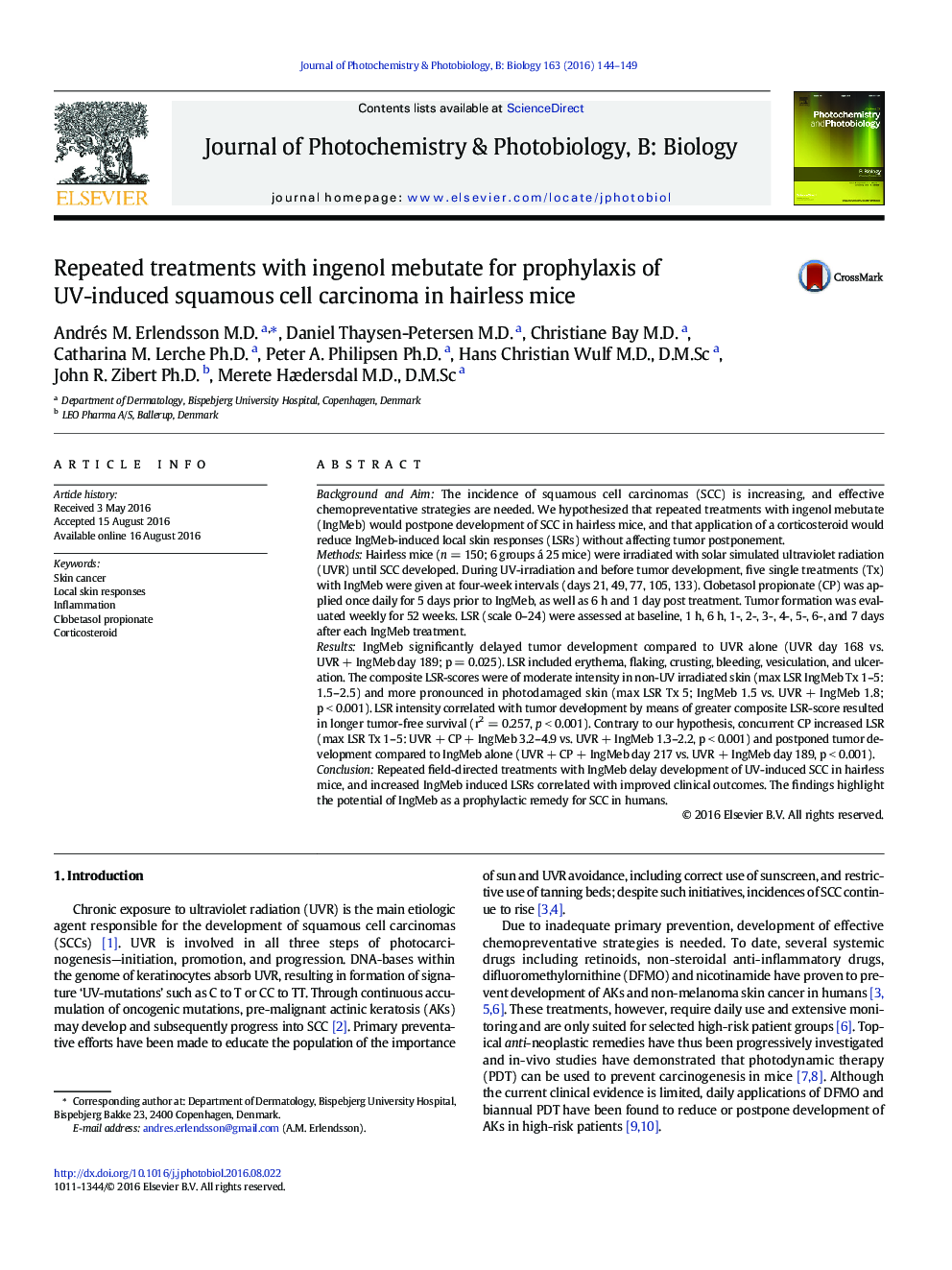| کد مقاله | کد نشریه | سال انتشار | مقاله انگلیسی | نسخه تمام متن |
|---|---|---|---|---|
| 4754657 | 1418070 | 2016 | 6 صفحه PDF | دانلود رایگان |

- Repeated treatments with ingenol mebutate delayed formation of UV-induced squamous cell carcinomas (p = 0.025).
- Greater ingenol mebutate-induced local skin responses resulted in longer tumor-free survival (r2 = 0.257, p < 0.001).
- Concurrent clobetasol propionate treatment increased ingenol mebutate-induced local skin responses (p < 0.001)
Background and AimThe incidence of squamous cell carcinomas (SCC) is increasing, and effective chemopreventative strategies are needed. We hypothesized that repeated treatments with ingenol mebutate (IngMeb) would postpone development of SCC in hairless mice, and that application of a corticosteroid would reduce IngMeb-induced local skin responses (LSRs) without affecting tumor postponement.MethodsHairless mice (n = 150; 6 groups á 25 mice) were irradiated with solar simulated ultraviolet radiation (UVR) until SCC developed. During UV-irradiation and before tumor development, five single treatments (Tx) with IngMeb were given at four-week intervals (days 21, 49, 77, 105, 133). Clobetasol propionate (CP) was applied once daily for 5 days prior to IngMeb, as well as 6 h and 1 day post treatment. Tumor formation was evaluated weekly for 52 weeks. LSR (scale 0-24) were assessed at baseline, 1 h, 6 h, 1-, 2-, 3-, 4-, 5-, 6-, and 7 days after each IngMeb treatment.ResultsIngMeb significantly delayed tumor development compared to UVR alone (UVR day 168 vs. UVR + IngMeb day 189; p = 0.025). LSR included erythema, flaking, crusting, bleeding, vesiculation, and ulceration. The composite LSR-scores were of moderate intensity in non-UV irradiated skin (max LSR IngMeb Tx 1-5: 1.5-2.5) and more pronounced in photodamaged skin (max LSR Tx 5; IngMeb 1.5 vs. UVR + IngMeb 1.8; p < 0.001). LSR intensity correlated with tumor development by means of greater composite LSR-score resulted in longer tumor-free survival (r2 = 0.257, p < 0.001). Contrary to our hypothesis, concurrent CP increased LSR (max LSR Tx 1-5: UVR + CP + IngMeb 3.2-4.9 vs. UVR + IngMeb 1.3-2.2, p < 0.001) and postponed tumor development compared to IngMeb alone (UVR + CP + IngMeb day 217 vs. UVR + IngMeb day 189, p < 0.001).ConclusionRepeated field-directed treatments with IngMeb delay development of UV-induced SCC in hairless mice, and increased IngMeb induced LSRs correlated with improved clinical outcomes. The findings highlight the potential of IngMeb as a prophylactic remedy for SCC in humans.
Journal: Journal of Photochemistry and Photobiology B: Biology - Volume 163, October 2016, Pages 144-149